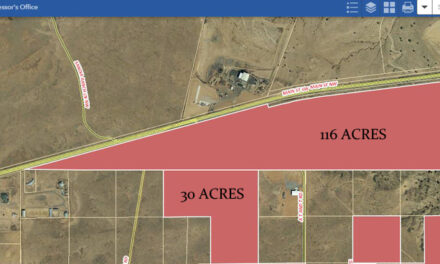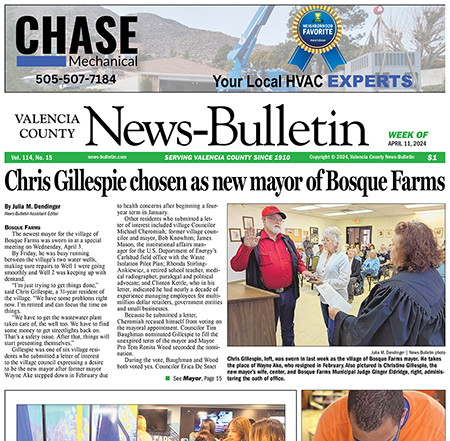The New Mexico State University Cooperative Extension Service-Valencia County is making a last ditch effort to stay alive by joining efforts with the Valencia Soil and Water Conservation District in asking landowners to approve a half-mill levy which will generate funds to keep the extension service doors open.
Landowners will go to the polls Tuesday, June 18. There will be two polling places: La Merced Elementary and Los Lunas Elementary. Voters are asked to present their most recent tax notice. The polls will be open from 7 a.m. to 7 p.m.
If the half-mill levy does not pass, programs affecting 2,130 youth are in jeopardy.
“There is a lot of discussion regarding what will happen if the half-mill levy does not pass,” said Frank Holguin, extension service field agent for Valencia County. “The debate is whether to keep a skeleton crew to get through the program year or to just close the doors. No one wants to leave the kids hanging, with the county and state fair coming up. But there is a lot of debate regarding Valencia County setting precedents for other counties.”
The half-mill levy is an answer to the impact of the Valencia County budgetary problems which forced the county commission to stop providing its portion of the extension service and conservation district budgets.
“Because of the problems the county is having with its finances, we decided we needed to find a way to support ourselves,” said Dale Jones, vice chair of the Valencia Soil and Water Conservation District (VSWCD).
In looking for a solution to the funding problems for the two agricultural programs, the VSWCD board of supervisors opted to access a portion of the state law that established the soil and water conservation districts. It gives each district the taxable authority of up to one mill for support of their programs if approved by landowner voters.
“Unfortunately, the extension service does not have this same authority. So we decided to combine our two needs and go to the voters with a half-mill levy,” Jones said.
“We are asking the community to pass the 10-year levy. By law, we could ask for a full mill levy, but we decided our program needs can be met with half a mill,” Jones said.
Half a mill on property with a $100,000 market value, which has an assessed value of $33,000, will be $16 a year.
Because of state statutes, farm cropland’s taxable value is $465 per acre, with an assessed value of $155 per acre. The half mill levy tax would be approximately 7 cents per acre.
“We are guessing it will average $10 a year for the average property owner,” Jones said.
The conservation district and extension service estimate their budget for the anticipated $360,000 annually will be $80,000 for the extension service programs, $165,000 for farmland projects, $75,000 for open space and urban projects, and $40,000 for personnel costs.
“We plan to cover all of the extension service’s costs for two years, then drop off by 25 percent for the next three years. We don’t want this to be a forever deal,” said Jones.
“We have a proposed budget for the conservation district, but, because we are dealing with some unknowns, like what the exact funding will be and how many people will apply for the various programs, we must have some built-in flexibility.”
“We are working to establish an advisory group from the community to help in planning the allocation of funds to segments of the program.”
The VSWCD is inviting various groups, such as the Valencia County Farm and Livestock Bureau and neighborhood associations, to participate in the advisory group.
The conservancy district’s programs encourage and promote soil and water conservation as well as the wise use and care of all natural resources.
The conservation programs include helping farmers to make their irrigation efficient, remove aggressive weeds that are displacing native plants and protect their farmland.
“The seven member VSWCD board approves grants to land owners to help with conservation projects,” Jones said. “Projects such as leveling their land so irrigation water flows better and conserves water. Or replacing earthen ditches with cement-lined ditches to prevent water loss to weeds and gophers.”
With passage of the mill levy, Jones said, the board would be able to increase the portion of the cost-share of projects from 50-50 to 75-25. The program would also be available for farmers who have not been able to qualify for federal funds in the past.
“We plan to provide assistance to landowners to protect their fields from excessive damage from migrating sandhill cranes,” he said.
Other projects supported by the conservation district protect the greenbelt along the Rio Grande.
The district’s work also impacts open space and urban areas with bosque restoration, open space projects and nature trails.
“With the mill-levy money, we can complete a plan to connect the valley from Bosque Farms to Belen with a trail system for a variety of users,” Jones said. “We want to assist in creating a bosque which is healthy and provides for both human and wildlife needs.
“Our goal is to provide Valencia County with the best service possible at a time when water issues and expanding urban growth are at the forefront of factors affecting the area.”
Such an optimistic conservation program cannot be completed overnight, according to Jones. “But, with the mill-levy funds, time and matching federal dollars, Valencia County can become a proud place to live,” he said.















